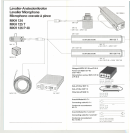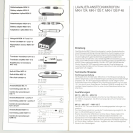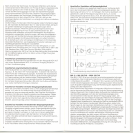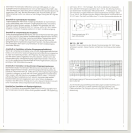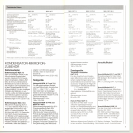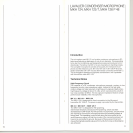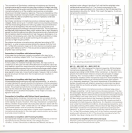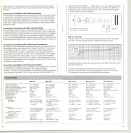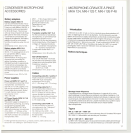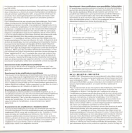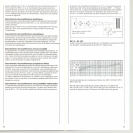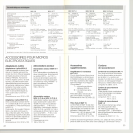
The connection 01Senn heiser condenser microphones and dynamic
microphones as weil is carried out using the principle 01voltage matching.
The advantages 01this system are that neither impedance variations 01the
microphone output nor 01the amplilier input exercise a noticeable
influence on the total Irequency response. The source impedance 01the
Sennheisercondenser microphone with A-B powering is so low (approx.
20 Q at 1000 Hz) that an amplilier input with an impedance 01at least
200 Q will be suitable.
Sennheiser condenser microphones produce relatively large output
voltages, these can be up to 1 volt with maximum sound pressure levels.
This has the advantage that even with long cables induced interference
signals can be disregarded. Also the internal noise produced by the
microphone does not contribute to the total noise level. The microphones
are litted with high Irequency lilters, which ensure that no high Irequency
signals lrom the microphone can affect the external circuitry, and also that
the microphone itsell is protected Irom high Irequency disturbance. It is,
therelore, notnecessary, even underthe most difficult conditions, totake
special precautions such as double screening 01the cables or the
provision 01high Irequency Iilters.
Sennheiser condenser microphones are polarised according to DIN
standard i. e. when apressure signal strikes the capsule lrom the Iront,
Pin 1 01the DIN-connector (resp. pin 2 01the Gannon connector) goes
positive with relerence to Pin 3. This should be considered when the
amplilier input is being wired.
Connection to Amplifiers with balanced Inputs
In this case the microphone is simply connected to the input 01an
amplilier via a battery adapter MZA 15 or the power supply MZN 16 T.
Connection to Amplifiers with unbalanced Inputs
In many cases, lor example most tape recorders, the input socket is
unbalanced. Inthis case one side olthe b~lanced microphone output has
to be earthed. Apart lrom cases where the microphone is being used lor
prolessional studio purposes, this isnot critical, asthe large output voltage
01the microphone combined with its low output impedance provides a
large signal to noise ratio. Gare should be taken, however, that no multiple
ground circuits are lormed when the microphones are mounted on
tripods etc.
Connection to Amplifiers with High Input Sensitivity
In the amplilier being used has avery high input sensitivity, i.e. when itis
normally intended lor use with dynamic microphones, it can be necessary
to reduce the output voltage Irom the microphone by means 01a voltage
divider. This should be built into the microphone cable at the amplilier
input. By this means the large signal on the microphone cable is
maintained up to just belore the amplilier, which helps to increase the
signal to noise ratio.
Connection to Amplifiers with Defined Input Impedances
Sennheiser studio condenser microphones can be connected directly
to all ampliliers whose input impedance is larger than 200 Q. This is usual
in the majority 01cases. However, il the input impedance is smaller than
200 Q, a resistor 01appropriate value should be placed in series with the
microphone so that it "sees" at least 200 Q. The voltage division caused
by this series resistor must 01course be considered.
The same method can be used when a higher output impedance 01the
microphone is demanded. In this case again aseries resistor can be used
to provide correct matching.
Connection to Amplifiers with Powering Facilities
1Ian appropriate voltage source is available in the amplilier the condenser
microphone can be powered directly. The voltage should be
12.volts :t 2 volts. It should be so stabilised and liltered, that the un-
12
weighted noise voltage is less than 5 f.lVand that the weighted noise
components are less than 2 f.lV.The current consumption 01the
microphone is approximately 6 mA. According to the DIN standard the
leed resistors should be 2 x 180 Q. This means that approx. 2 volts are
lost across the resistors. .
,n-Tnnnn,
I I
I I
I I
I I
I
I I
I I
I I
I
T
I
'_n- nnnn_'
!-~-I
II
,n-
===l~i
180Q 'nn' L_-
(':n-7-"'.
I I I I
" I I
, . ~---, /b
I
180Q
A-BpoweringaccordingtoDIN45595
W
" S
12V
+
360Q +12V
,_nTn_nn_,
I I
I I
I I
I I
I I
I I
I I
I I
:_n_L___n_nl
NF
+,c-
-12V
,mrm :
I I
I I
i : -
I
I I
I I
I I
:n__L n__1
i+
NF
,::,:.,<.n_"1) b
A-B powering unbalanced connection
\
I
MK 12 + MH 126 P48 = MKH 126 P48
The MKH 126 P 48 is designed lor phantom powering. All Sennheiser
microphones designated MKH . . . P 48 and P48-U are 48 V phantom-
powered according to DIN 45596. Either condenser- or dynamic micro-
phones Irom Senn heiser electronic employ the principle 01voltage
matching. This "no load condition" has the advantage that neither
impedance variations 01the microphone output nor 01the amplilier input
have a noticeable inlluence on the total performance 01the system
(e. g. Irequency response). The source impedance 01Senn heiser con-
denser microphones with phantom powering is extremely low (about
20 Q at 1000 Hz) so that the amplilier input impedance has only to be
at least 200 Q.
Senn heiser condenser microphones produce relatively large output
voltages exceeding 1 volt at maximum sound pressure levels. This has
the advantage that even with long cables induced interference signals can
be disregarded. Also the internal noise produced by the microphone does
not contribute to the total noise level. The microphones are litted with
RF lilters which ensure that no high Irequency signals lrom the micro-
phone can affect the external circuitry and that the microphone itsell is
protected Irom high Irequency disturbance. It is therelore not necessary,
even under the most difficult conditions, to take special precautions, such
as double screening 01the cables or the provision 01high Irequency lilters.
Senn heiser condenser microphones are polarised according to DIN
stahdard i. e. when apressure pulse strikes the capsule lrom the Iront,
Pin 1 01the DIN-connector (resp. pin 2 01the Gannon connector) goes
positive with relerence to Pin 3. This should be considered when the
amplilier input plug is being wired lor correct phasing.
Connection to Amplifiers with balanced Inputs
Phantom-powered microphones are generally to be connected to
balanced ground-Iree translarmer inputs.
13




